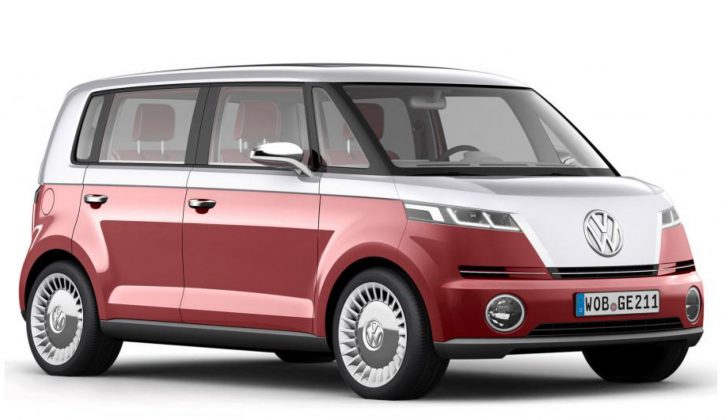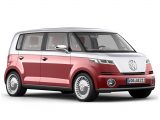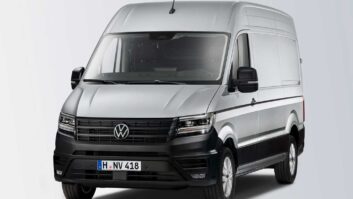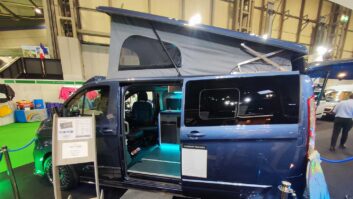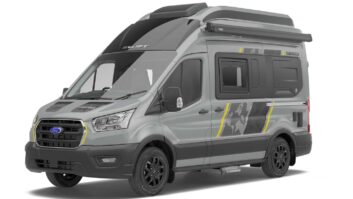Reports from our sister magazine Autocar suggest that there are some exciting times ahead if you are in the market for a Volkswagen camper.
At the most conventional end of the spectrum, the replacement for the T5 Transporter is due to arrive before the end of 2015. While the current version of the compact, front-wheel drive panel van is getting a little long in the tooth after nine years on the market, there is no denying it remains a class act. The VW is beautifully built, comfortable and refined, but rivals are now greener and beginning to narrow the gap on cabin quality, too.
The first drawings of the new ‘T6’ Transporter appeared a month or so back, and as is the way with Volkswagen passenger cars, the looks could be described as classy, discreet and perhaps a little, dare I say it, boring. Hopefully by the time the new ‘van is revealed in the metal later in the year, it will be a more striking product.
At the recent New York Auto Show however, there was some potentially exciting news about an interesting new development, as reported by Autocar. Volkswagen board member Dr Heinz-Jakob Neusser alluded to an all-new Camper concept vehicle which makes use of an electric powertrain.
Neusser revealed that VW engineers were assessing a platform using a small electric motor driving the front wheels and battery packs stored under the floor to provide the power. This configuration is significant because of how it allows the rest of the vehicle to be designed.
Neusser of course knows how iconic the design of the original VW van was and it is no coincidence that he chose to speak about it in the USA, where the original was so popular. Attempts to recreate the appeal have proved tricky, however, as it is hard to replicate the features which made it so good as a basis for a campervan.
He says that attempts at a new model need three “very important” design cues: “First the wide, solid, D-pillar, second the boxy design of the centre section and, thirdly, the front end must have a very short overhang. The distance from the A-pillar to the front end must be very short.”
Achieving this unique front-end design is made possible if the drivetrain is concealed under the floor, rather than under a conventional bonnet. This frees up the design to allow the A-pillars to be placed much further forward than in a conventional MPV.
Such a car, he said, with an attractive cost base, could make it into production. Work on the concept was currently ongoing at VW, Neusser confirmed.
Plainly, such an approach is not without problems to overcome. Firstly, with so little metalwork ahead of the driver, there will need to be some clever engineering to ensure the design can meet the relevant crash legislations.
And, depending on the kind of travelling you like to do, while a low-profile electric motor may be brilliant news for packaging and also in terms of emissions, if you can only drive 150 miles before you need to park and recharge for four hours, you may find yourself doing a little more local touring than you are used to.
In terms of the likelihood of such a vehicle making production, it would seem to be a little at odds with Volkswagen’s current thinking elsewhere in the company’s portfolio. In order to control costs and speed up the development of new models, it uses a modular system.
The smallest cars are one Meccano set shared with Škoda and SEAT. The medium to larger cars use a further system shared with all the sister companies, and the biggest use a third modular kit predominantly configured for posh Audi executive cars. In commercial vehicles, small ones share the car technology, while the larger Crafter van shares development costs with Mercedes-Benz.
All of which makes the idea of a bespoke, front-wheel drive, electric commercial vehicle platform with limited appeal beyond niche markets seem pretty unlikely. After all, even the niche-appealing Beetle is actually a VW Golf in a flower power frock.
It’s not necessarily a bad thing, however.
Having the brightest minds of Volkswagen’s engineering teams turning their sights to solving common campervan packaging problems, while building an electric camper concept, might just make the new T6 a lot more exciting than those tame early sketches look. And I can’t wait to see what they come up with.
VW is assessing a platform using a small electric motor driving the front wheels, with battery packs stored under the floor
